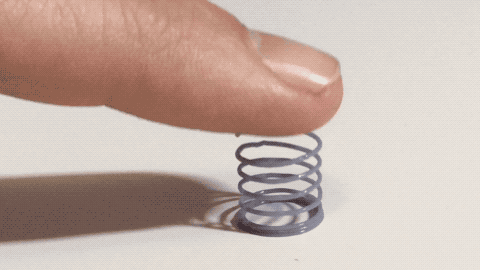A collection of springs demonstrates a new FFF hack to 3D print extreme overhangs without using any supports.
The technique has been developed by Makefast Workshop, a prototype and design bureau based in Dealware, Ohio.
In addition, the Makefast team has created a G-code generator for the springs, making experimentation open to anyone.
3D printing in midair
As pointed out by the team at Makefast, midair 3D printing has been achieved before in a handful of experiments: either one offs, or in research labs. Most recently, for example, the University of Illinois Urbana-Champaign developed a hypnotizing technique for 3D printing sugar sculptures in midair. While such developments could have great potential in an experimental lab environment, Makefast Workshop sought a method that would give makers the opportunity to try this technique at home.
As the team write in a corresponding Hack blog post, “Have you ever noticed that at the end of a print there’s sometimes a small thread of plastic that seems to follow the exact path of the extruder after it finishes printing? This is often caused by a little extra filament continuing to flow/ooze as the print head pulls away. The plastic is thin enough to cool as it moves, tracing out the path in midair,”
“While those little threads aren’t likely to be very useful, we wondered if we could apply that same approach to purposely trace out a 3D contour.”
How to 3D print extreme overhangs
To 3D print sample springs without using supports, Makefast deciphered at least four essential observations.
First and foremost, extrusion flowrate must be kept close, roughly 1:1 for the distance traveled. This ensures that the right amount of plastic is extruded, no more less, so the spring doesn’t get too thin, or just ooze out in a uncontrollable mess.
Second of all, print speed has to be incredibly slow, allowing time for the plastic to solidify. Though miniature, each of the springs demonstrated by the team took between three and seven minutes to complete.
Proper filament care is essential success. Any moisture trapped in those filaments can lead to instant failure of springs.
And finally, compensations have to be made for the extruder’s pull. As a result “the G-code for a cylindrical coil spring actually flares out slightly near the top to produce a spring that is straight when completed.”

What does this mean for 3D printers?
The overall vision for this experiment is to develop some kind of method that makes 3D printing overhangs less dependent on angles and support structures.
As the team state, “Imagine a long overhang being accomplished by momentarily slowing down a print and snaking a strand of filament away from a part and then back. Making a set of these loops could then be used as a shelf to build up subsequent layers without requiring support underneath.”
Improvements to desktop FFF systems have been made before by experimenting with slicing and g-code. One example includes the variable layer height setting introduced by Prusa Research to its version of Slic3r. By adding this feature, it made it possible to achieve smoother prints, without completely sacrificing on print time.
While midair settings aren’t currently offered by slicing software, the Makefast Workshop custom g-code generator is certainly a good place to start for anyone looking to give this technique a try.
For all of the latest 3D printer news and hacks subscribe to our newsletter. You can also follow us on Facebook and Twitter. Visit 3D Printing Jobs to take your career to the next level.
Featured image shows different shaped springs 3D printed without supports. Photo via Makefast Workshop



